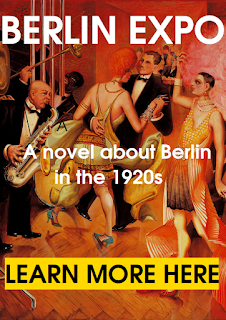In the German TV-series Babylon Berlin, a great deal of the action takes place in a
nightclub called Moka Efti. You would look in
vain for that place in today’s Berlin. But, had you been there back
in the 1920s, you had been luckier.
There was indeed one
Moka Efti in Berlin in those days, but it was not really a nightclub,
it was rather a cafe, situated where Leipziger Strasse meets
Friedrichstrasse. It opened in April 1929, in the 1st and 2nd floors
of a massive building from the 19th century known as the
Equitable-Palast, and it was named after its Greek-Italian owner, Mr
Giovanni Eftimiades. As to the word "moka", it has its
origin in a Yemenite city called Mocha, an important market-place for
coffee from the 15th to the 18th century.
At a later time,
Eftimiades purchased a larger two-floor palais, on the
Friedrichstrasse.
The decor inside the
original place was even wilder than anything the TV producers'
imagination could fantasize. One of the most striking features was
the escalator that took customers from the ground floor to the first
floor. People came to Moka Efti with the sole purpose of admiring the
escalator; escalators were a new amenity, still rare in 1929. For the
opening, the owner organized a contest : those who rightly guessed
the number of visitors that used the escalators in one day were
rewarded with the sum of one thousand marks.
In the TV series,
Berlin’s superclub has a futuristic design with stripped-back walls
and geometric towers of light. Modern architecture being fashionable
in Weimar Germany, that doesn’t strike one as especially out of
place (or time). Still, the original joint was more backward-looking.
Customers could marvel at Moorish arches, panoramic paintings and
Turkish and Egyptians salons, all in a style reminding of the 1001
Arabian Nights.
 |
There was a billiard
hall, a barber shop and correspondence room filled with typists ready
to take dictation. A white marble pastry shop connected to a bar via
a corridor that was designed to look like a sleeper train on the
Orient Express.
In the 1930s, the
swing band of James Kok became the house orchestra. It played in the
1st floor while the dancing room was in the 2nd. The solution :
an opening in the floor, which allowed the guests to dance to the
rythms of the orchestra downstairs.
The dance scenes in
Babylon Berlin were shot in the auditorium of the Delphi cinema, in
Berlin-Weissensee. But the glass façade was built by Uli Hanisch at
the Babelsbergs studios.
 |
| The Delphi at Weissensee |
 |
| The "fake" façade at Babelsberg |
If Moka Efti doesn’t
exist anymore (it was destroyed during WWII), there is since some
months ago a dance hall in Berlin-Kreuzberg where an orchestra,
called Moka Efti, plays the music of the series.
Along with the HausVaterland on Potsdamer Platz, where model trains and miniature planes
on strings zipped among the coffee drinkers, Moka Efti was one of the
most prominent themed establishments offering exotic entertainment. Unlike in the series, there was no brothel in the basement at Moka Efti, but the link is not far-fetched: a number of dance
halls were markets for prostitution as well. And there were not just
women offering escort services : the director Billy Wilder is said to have worked as a “taxi dancer” at a Berlin hotel in
1926. Which is not to say that his job included sexual services, though.
The
picture above shows Charlotte Ritter entering the basement of café Moka
Efti, which, unlike
the ground floor, was (in the TV-series, not in the real Moka Efti) a
brothel. Charlotte can of course not be described as a "whore". Though
young, she is the provider of a family of 5-6 persons and she tries to
make a living out of taking occasional clerical jobs at the High
Commission of Berlin police. But, those small jobs not being enough to
make both ends meet, she does sell sex on occasions, at Moka Efti's
basement. When no customer requires her services, she amuses herself at
the nightclub like any other guest.
It is surprising how thin the line could be between prostitution and "decent life" in 1920s Berlin. And in the TV-series we can see how easily customers glide between the restaurant part and the brothel, which has nothing specially clandestine about it. They had, though, to be waved through by the receptionist, the scantily clad lady to the left of the picture above.
More about similar places in 1920s Berlin, in this link.
It is surprising how thin the line could be between prostitution and "decent life" in 1920s Berlin. And in the TV-series we can see how easily customers glide between the restaurant part and the brothel, which has nothing specially clandestine about it. They had, though, to be waved through by the receptionist, the scantily clad lady to the left of the picture above.
More about similar places in 1920s Berlin, in this link.









No comments:
Post a Comment